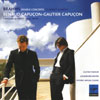Brahms Double Concerto
Young Capuçons meet late Brahms and the brother have a real winner here
View record and artist detailsRecord and Artist Details
Composer or Director: Johannes Brahms
Label: Virgin Classics
Magazine Review Date: 2/2008
Media Format: CD or Download
Media Runtime: 72
Mastering:
Stereo
DDD
Catalogue Number: 395147-2

Tracks:
| Composition | Artist Credit |
|---|---|
| Concerto for Violin, Cello and Orchestra |
Johannes Brahms, Composer
Gautier Capuçon, Cello Gustav Mahler Youth Orchestra Johannes Brahms, Composer Myung-Whun Chung, Conductor Renaud Capuçon, Violin |
| Quintet for Clarinet and Strings |
Johannes Brahms, Composer
Aki Saulière, Violin Béatrice Muthelet, Violin Gautier Capuçon, Cello Johannes Brahms, Composer Paul Meyer, Clarinet Renaud Capuçon, Violin |
Author: Harriet Smith
Within months of the acclaimed new recording from Julia Fischer and Daniel Muller-Schott, here’s a very fine reading of Brahms’s Double Concerto from the stellar young Capucon brothers. They seem incapable of setting a foot wrong on disc and they put their considerable chamber-music experience to great use in Brahms’s final orchestral work, with Gautier Capucon proving an eloquent lead in the vehement first movement.
The other striking aspect about this performance is the sheer range of colour, not only from the soloists but also from the Mahler Youth Orchestra, who play their hearts out for Myung-Whun Chung in this most symphonic of concertos. If I still find Oistrakh and Fournier irresistible in the slow movement, offering a perfect balance of melodic lines that are lovingly cherished but never saccharine, the Capucons are still very impressive, and their finale is full of vitality, making much of the folk-tinged inflections and achieving a seemingly telepathic unanimity in their shared passages.
For a change from the usual concerto companion we get Brahms’s Clarinet Quintet, written in 1891, four years after the Double. In this coupling it’s easy to hear the Quintet’s famous autumnal quality prefigured in the outer sections of the concerto’s Andante. Paul Meyer is an ideal protagonist, producing a wide array of mellow shadings in the opening movement, yet never underplaying the more agitated passages within the piece, notably the Presto of the third movement. The quartet are minutely responsive to Meyer’s every move and even seasoned Brahms aficionados will find new detail to relish in both the performances here.
The other striking aspect about this performance is the sheer range of colour, not only from the soloists but also from the Mahler Youth Orchestra, who play their hearts out for Myung-Whun Chung in this most symphonic of concertos. If I still find Oistrakh and Fournier irresistible in the slow movement, offering a perfect balance of melodic lines that are lovingly cherished but never saccharine, the Capucons are still very impressive, and their finale is full of vitality, making much of the folk-tinged inflections and achieving a seemingly telepathic unanimity in their shared passages.
For a change from the usual concerto companion we get Brahms’s Clarinet Quintet, written in 1891, four years after the Double. In this coupling it’s easy to hear the Quintet’s famous autumnal quality prefigured in the outer sections of the concerto’s Andante. Paul Meyer is an ideal protagonist, producing a wide array of mellow shadings in the opening movement, yet never underplaying the more agitated passages within the piece, notably the Presto of the third movement. The quartet are minutely responsive to Meyer’s every move and even seasoned Brahms aficionados will find new detail to relish in both the performances here.
Discover the world's largest classical music catalogue with Presto Music.

Gramophone Digital Club
- Digital Edition
- Digital Archive
- Reviews Database
- Full website access
From £8.75 / month
Subscribe
Gramophone Full Club
- Print Edition
- Digital Edition
- Digital Archive
- Reviews Database
- Full website access
From £11.00 / month
Subscribe
If you are a library, university or other organisation that would be interested in an institutional subscription to Gramophone please click here for further information.




